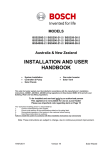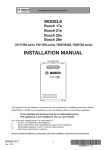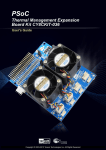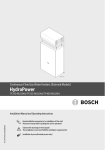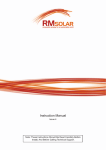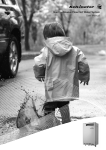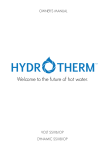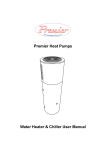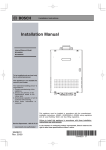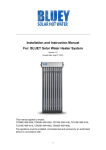Download Alpha Solar SolaStat-Eco Specifications
Transcript
DHW, Domestic Hot Water Cylinder BSS 2C-250-21-2 / BSS 2C-250-26-2 BSS 2C-340-21-2 / BSS 2C-340-26-2 BSS 2C-400-21-3 / BSS 2C-400-26-3 BSS 2C-250-2E / BSS 2C-340-2E BSS 2C-400-3E 6 720 618 429 (2011/01) AU/NZ Installation and maintenance instructions for contractors This solar hot water system must be installed in accordance with the manufacturer's installation instructions, AS5601, AS3500.4. AS3000 wiring regulations (in New Zealand NZBC G12) and all Local Building, Water and Gas fitting regulations. To be installed and serviced only by an authorised person The “authorised installing person” is responsible for: 1. Correct commissioning of this system. 2. Ensure units performs to the specifications stated on the rating label. 3. Demonstrate operation of the system to the customer before leaving. 4. Hand these instructions to customer. Failure to install this system in accordance with these installation instructions may void warranty. Note: These instructions are subject to change, due to continuous product improvement. 2 | Table of Contents AU/NZ Table of Contents 1 1.1 1.2 Key to symbols and safety instructions Explanation of symbols Safety instructions 3 3 3 6.3 6.4 6.5 6.6 Adjusting the flow rate Fitting the casing shell After commissioning User information from the system installer 25 25 26 26 2 2.1 2.2 2.2.1 5 5 5 7 7.1 7.2 Shutting down Shutting down the DHW cylinder Shutting down the DHW cylinder if there is a risk of frost 27 27 2.3 2.4 2.5 2.6 Product information Standard delivery Product description Main components of the solar circuit pump and safety assemblies Correct use Tools, materials and auxiliary equipment Dimensions and connections Specification 8 Environmental protection/disposal 28 Regulations 10 Maintenance Checking the magnesium anodes Restarting the DHW cylinder after maintenance 29 29 3 9 9.1 9.2 4 Shipping 11 Warranty details 31 5 5.1 5.1.1 5.1.2 5.2 5.3 5.3.1 5.3.2 5.3.3 Installation Location Requirements for installation location Positioning the DHW cylinder Removing the casing shell Water connections Connection options Connecting the solar thermal system Pipe Connections to Gas Booster or Electric Booster and DHW Network Fitting the PTR valve Checking for leaks Installing the temperature sensors Installing the DHW temperature sensor Collector temperature sensor Electrical connections Making the electrical connections to the SolaStat-Eco solar controller Connect the electric heating element electrically (for electric boost ONLY) Gas Booster Installation 12 12 12 12 13 14 14 14 Commissioning the system Commissioning the DHW cylinder Purging and filling Purging the pipework Carrying out pressure test with water Replacing water with heat transfer medium Verifying that the solar thermal system is free of air Determining the operating pressure Filling with water 21 21 21 21 22 23 5.3.4 5.3.5 5.4 5.4.1 5.4.2 5.5 5.5.1 5.5.2 5.5.3 6 6.1 6.2 6.2.1 6.2.2 6.2.3 6.2.4 6.2.5 6.2.6 6 720 618 429 (2011/01) 6 7 7 8 9 16 17 17 18 18 18 19 19 19 20 24 24 24 10 27 30 AU/NZ Key to symbols and safety instructions | 3 1 Key to symbols and safety instructions 1.1 Explanation of symbols Warnings 1.2 Safety instructions Installation, conversion Warnings in this document are framed and identified by a warning triangle printed against a grey background. If there is a danger due to electricity, the exclamation mark in the warning triangle is replaced by a lightning symbol. Signal words at the start of a warning indicate the type and seriousness of the ensuing risk if measures to prevent the risk are not taken. • NOTICE indicates that material losses may occur. B Risk of fire from soldering and welding! Take appropriate protective measures when soldering and welding as the thermal insulation is flammable, for example cover the thermal insulation. B Ensure that the DHW cylinder is installed or converted by an authorised contractor only. B Use installation materials that are sufficiently heatresistant. Function B Observe these installation and maintenance instructions to ensure trouble-free operation. • CAUTION indicates that minor to medium injury may occur. B Never close the blow-off line of the PTR valve. During heating, water may be ejected for safety reasons. • WARNING indicates possible severe personal injury. Danger from electrical currents • DANGER indicates a risk to life. B Ensure that any electrical work is only carried out by an approved electrician. Important information Important information where there is no risk to people or property is indicated with the adjacent symbol. It is bordered by lines above and below the text. Additional symbols Symbol Meaning B Action step Æ Cross-reference to other parts of this document or to other documents • List/list entry B Before removing the casing shell, isolate all poles of the solar thermal system and secure against unintentional reconnection. Risk of scalding at the hot water draw-off points B When the DHW cylinder is in operation, temperatures in excess of 50 °C can occur. To limit the draw-off temperature, fit a thermal DHW mixer. B This heater supplies water at a temperature exceeding 50 °C. A tempering valve must be fitted between the water heater and the outlets in bathrooms and ensuites to comply with the water temperature requirements of AS 3500.4. Tab. 1 6 720 618 429 (2011/01) 4 | Key to symbols and safety instructions Using the electric heating element (BSS 2C-250-2E / BSS 2C-340-2E / BSS 2C-400-3E) B Ensure that any electrical work is only carried out by an approved electrician. B Before starting electrical work on the solar thermal system, isolate all poles of the system and secure against unintentional reconnection. B Ensure the system has been isolated from the supply. For operation with the electric heating element, observe the following points in order to maintain the corrosion protection and to adhere to the guidelines for electrical safety: B Do not operate electrically heated DHW cylinders with an inert anode. B Use metal connection fittings in DHW heating systemswith plastic lines. B Use original electric heating element only. B When installation of the cylinder is complete, inspect the earth conductor (including metal connection fittings). Maintenance B Customer recommendation: Arrange a maintenance and inspection contract with an approved contractor. Have the DHW cylinder inspected and, if required, serviced annually. B Only original spare parts must be used. 6 720 618 429 (2011/01) AU/NZ AU/NZ Product information | 5 2 Product information 2.1 Standard delivery The DHW cylinder is delivered fully assembled with the solar circuit pump attached. The following parts of the standard delivery are packed separately: • SolaStat-Eco solar controller • Pressure-temperature relief (PTR) valve • Foot bolts • Technical documentation 2.2 Product description The BSS 2C-250/340-2E, BSS 2C-400-3E DHW cylinder is equipped with an electric heating element. The BSS 2C-250/340-21-2, BSS 2C-250/340-26-2, BSS 2C-400-21/26-3 DHW cylinder operates with a gas fired external water heater booster. The main components of the DHW cylinder are: • Storage cylinder with corrosion protection The cathodic corrosion protection comprises the hygienic thermal glaze and two magnesium anodes. • Bare-tube heat exchanger The bare-tube heat exchanger transfers the energy from the solar circuit to the DHW inside the storage cylinder. The DHW is heated evenly. • Thermal insulation The thermal insulation, made from CFC-free hard polyurethane foam, is directly applied to the storage cylinder and insulates against heat loss. Fig. 1 1 2 3 4 5 6 7 Sectional view of DHW cylinder Foot bolts Bare-tube heat exchanger (solar thermal system) Thermal insulation Thermal glaze Storage cylinder Magnesium anodes Sensor well • Sensor well with DHW temperature sensor The DHW temperature sensor supplies temperature information to the control. NOTICE: This appliance must not be used as a pool heater. 6 720 618 429 (2011/01) 6 | Product information • Solar circuit pump assembly The solar circuit pump assembly supplies the solar circuit. • Casing shell AU/NZ 2.2.1 Main components of the solar circuit pump and safety assemblies The solar circuit pump and safety assemblies (Æ Fig. 3) are pre-assembled on the DHW cylinder. • Casing lid • Electric heating element (for SM250/340/400 E BO only) In addition to the collectors, the electric heating element is an additional heat source for DHW heating. • Solar controller (not shown here) The SolaStat-Eco solar controller switches the solar circuit pump on and off subject to the temperature differential between the collector sensor and the DHW temperature sensor. 6 720 618 426-03.1RS Fig. 3 1 2 3 4 5 6 Fig. 2 1 2 3 4 5 6 7 8 DHW cylinder Casing shell Expansion vessel Casing lid PTR valve Electric heating element (for SM electric Boost only) Thermal insulation Solar circuit pump assembly Safety assembly 6 720 618 429 (2011/01) Solar circuit pump and safety assemblies Pressure gauge in the safety assembly Ball valve with thermometer (blue = return) and integrated gravity brake (position 0° = normal running, 45° = gravity brake bypassed) Solar circuit pump Flow limiter Drain & fill valve (DFV) Flow rate indicator AU/NZ 2.3 Product information | 7 Correct use The DHW cylinder is designed for heating and storing domestic hot water. Please observe all DHW regulations, guidelines and standards for your country. Operate the DHW cylinder via the solar circuit using heat transfer medium only and in sealed unvented systems only. The solar pump station may only be used for the operation of solar thermal systems in conjunction with suitable controllers from the same manufacturer. The solar pump station is exclusively intended for operating solar thermal systems filled with propylene glycol/water mixtures. The use of any other heat transfer medium is not permitted. Any other application will be considered incorrect use. No liability for any losses resulting from such use is accepted. 2.4 Tools, materials and auxiliary equipment You need standard tools for the installation and maintenance of the DHW cylinder, as used in gas and water installations. In addition, a hand trolley with a strap may also be useful. 6 720 618 429 (2011/01) 8 | Product information 2.5 Fig. 4 AU/NZ Dimensions and connections Dimensions and connections AW EH EK EL M DHW outlet Connection flange for electric heating element Cold water inlet Drain Test point for DHW temperature sensor of the solar thermal system PTR Pressure-temperature relief valve RS Cylinder return (solar thermal system) VS Cylinder flow (solar thermal system) Dimension SM250 xxx SM340 xxx SM400 xxx D 600 700 700 H 1517 1430 1650 H1 110 135 135 H2 585 610 610 H3 680 705 705 H4 1370 1275 1495 H5 300 325 325 H6 780 775 905 Tab. 2 Dimensions for Fig. 4 6 720 618 429 (2011/01) AU/NZ 2.6 Product information | 9 Specification DHW cylinder Cylinder capacity Standby capacity for electric heating element Diameter D Depth Height H 1) Minimum ceiling height of installation room2) DHW outlet (AW) thread Cylinder flow (solar thermal system; VS) and cylinder return (solar thermal system; RS) thread Cold water inlet (EK) and drain (EL) thread PTR valve connection thread Connection flange for electric heating element (EH) thread Dry weight3) Bare-tube heat exchanger (solar thermal system): Solar heat exchanger capacity Solar heat exchanger surface area Installation components: Permissible temperature: • Flow • Return (pump) Safety valve response pressure Safety valve Mains voltage for pump Maximum power consumption of pump Output of electric heating element (Grimwood) thread Flow and return connections (locking ring fittings) thread Maximum permissible values: DHW temperature DHW operating pressure Connection for flat-plate collectors: Number of flat-plate collectors Straight pipe length; Ø 15 mm (DN12) Tab. 3 l l mm mm mm mm mm mm SM250 xxx 250 120 600 800 1517 2050 mm mm mm kg 137 l m2 5.2 1.2 SM340 xxx 340 155 700 900 1430 1950 20 15 SM400 xxx 400 180 700 900 1650 2150 20 15 64 x 64 (M8 to 46 x 46) 197 213 7 1.6 7 1.6 °C 130 °C kPa A Watt mm 110 300 DN 15, 15 mm connection 230 V AC, 50 - 60 Hz 0.25 3600 15 °C kPa 95 850 2 2 m 3 7 Dimensions and specification 1) Incl. casing lid, excl. foot bolt. 2) Minimum ceiling height of the installation room required for the replacement of the magnesium anode. 3) Excl. contents, incl. packaging. 6 720 618 429 (2011/01) 10 | Regulations 3 AU/NZ Regulations Different or supplementary regulations (e.g. mains connection requirements) may apply subject to the installation location (e.g. in different countries or regions). B Observe the country-specific or regional regulations, guidelines and standards (e.g. those of the power supply utility) when installing and operating the DHW cylinder and the electric heating element. All installations must be carried out in accordance with AS/NZS3500.4, NZS5261, AS/NZS3000 and all local building, plumbing and electrical regulations. CAUTION: For sanitary fixtures used primarily for the purpose of personal hygiene that a temperature control device be fitted (such as a tempering valve) as per AS3498 must be used. AS 2239 Galvanic (sacrificial) anodes for cathodic protection AS 2712 Solar and heat pump water heaters- Design and construction AS 3498 Authorization requirements for plumbing products- Water heaters and hot-water storage tanks AS 3500.4 Plumbing and drainage Part 4: Heated water services AS 3688 Metallic connections and end fittings AS 4020 Testing of products for use in contact with drinking water AS 4692.1 Electric water heaters Energy consumption, performance and general requirements AS/NZS 60335.2.21 Household and similar electrical appliances-Safety Part 2.21: Particular requirements for storage water heaters Tab. 4 Standards 6 720 618 429 (2011/01) AU/NZ 4 Shipping | 11 Shipping WARNING: Risk of injury from carrying heavy loads and inadequately securing loads for transport. B Use suitable means of transportation, e.g. a hand trolley with strap. B Transport the DHW cylinder to the installation location. B Remove packaging. B Remove wood screws [1] from locking plate [2]. B Unscrew and remove locking plate. B Secure the DHW cylinder against slipping. Where possible, transport the DHW cylinder fully packed to the installation location. This ensures protection during handling. If you are transporting the DHW cylinder unpacked, use a transport net. Protect the connections against damage. B Position the hand trolley at the back of the packed DHW cylinder. B Secure the DHW cylinder to the means of transportation with a strap. Fig. 6 1 2 Fig. 5 Removing the locking plates Wood screws Locking plate Securing the DHW cylinder for transport 6 720 618 429 (2011/01) 12 | Installation 5 AU/NZ Installation The DHW cylinder is delivered as a fully assembled unit. B Check that the delivered package(s) are complete and in perfect condition (Æ Chapter 2.1, page 5). B Dispose of packaging in an environmentally responsible manner. 5.1 Location 5.1.1 Requirements for installation location The DHW cylinder may be installed either indoors or outdoors. NOTICE: System damage through inadequate load-bearing capacity of the supporting surface or unsuitable substrate. B Ensure that the installation area offers sufficient load-bearing capacity. NOTICE: System damage due to corrosion! B Install the DHW cylinder in dry condition. B Only install this DHW cylinder in sealed unvented systems. B Never use open vented expansion vessels. At least 500 mm clearance above and in front of the DHW cylinder is required for the replacement of the magnesium anode and the electric heating element (during maintenance). Fig. 7 1 2 Minimum wall clearances (in mm) Connection on the left-hand side Connection on the right-hand side 5.1.2 Positioning the DHW cylinder B Lift the DHW cylinder from the pallet and position it on a level floor that has adequate load-bearing capacity. B Tilt DHW cylinder slowly onto the pallet [1]. B Remove hexagon bolts [2]. B Pre-assemble foot bolts [3] to approx. 20 mm. B Stand the DHW cylinder upright at the installation location and level it using the foot bolts. B To comply with NZBC G12 Building code, please install cylinders with seismic straps as shown below: B Maintain the minimum height and minimum wall clearances in the installation room. (Æ Tab. 3, page 9 and Fig. 7). If the DHW cylinder is connected on the lefthand side, maintain a minimum wall clearance (A) of 500 mm. Fig. 8 6 720 618 429 (2011/01) Seismic Restraint of Storage Water Heaters 90 - 360 litres AU/NZ Installation | 13 B It is a requirement of the National Plumbing Code AS/ NZS3500.4.2 that new water heaters be installed in a safe tray where in the event of a leak, property may be damaged (ie internal installations). Installation of such trays must comply with Clause 4.4 and SubClauses 1 to 5 of the above mentioned Code. Fig. 9 1 2 3 5.2 Removing the casing shell B Remove four push rivets [1] from the casing shell. B Lift the casing shell [2] up and off. B Disconnect the earth wire [3] from earth conductor connection. Fitting the foot bolts Suitable surface (e.g. pallet) Hexagon bolts Foot bolts WARNING: If the hot water system is not used for two weeks or more, a quantity of highly flammable hydrogen gas may accumulate in the water heater. To dissipate this gas safely, it is recommended that a hot tap be turned on for several minutes or until the discharge of gas ceases. Use a sink, basin or bath outlet, but not a dishwasher, clothes washer or other appliance. During this procedure, there must be no smoking, open flame or any electrical appliance operating nearby. If the hydrogen is discharged through the tap, it will probably make an unusual sound as with escaping air. Fig. 10 Removing the casing shell 1 2 3 Push rivet Casing shell Earth wire 6 720 618 429 (2011/01) 14 | Installation 5.3 Water connections DANGER: Risk of fire through soldering and welding! AU/NZ 5.3.1 Connection options Hydraulic connections on the DHW cylinder can be routed out either to the left [A] or the right [B] through the casing shell. B Take appropriate protective measures when soldering and welding as the thermal insulation is flammable, for example cover the thermal insulation. LEFT RIGHT B Check thermal insulation after completion for perfect condition. WARNING: Risk to health through contaminated water! Work carried out without due care for cleanliness contaminates the potable water. B The water heater is not recommended for connection to a bore water supply. Many such sources contain contaminants harmful to the components of the solar system. If the system is connected to bore supply against our recommendation, warranty does not apply. See details on warranty page Fig. 11 Right-hand and left-hand versions B Install and equip the DHW cylinder hygienically in accordance with national standards and guidelines. B For more information regarding connection of the solar collectors, please see the solar collectors IM. B Flush the DHW cylinder and pipework thoroughly with potable water after installation. NOTICE: Damage through incorrect connectors! B Use installation material that is heatresistant to 150 °C. B Use metal connection fittings in DHW heating systems with plastic lines. B When using an electric heating element: When installation of the DHW cylinder is complete, inspect the earth conductor (including metal connection fittings). 6 720 618 429 (2011/01) 5.3.2 Connecting the solar thermal system B Connect collectors at the DHW cylinder's flow and return using piping. AU/NZ Installation | 15 B To prevent air locks: route the pipes from the cylinder to the collector field on a rising incline. Connecting piping B Copper pipes for solar thermal systems should always be soldered with brazing or silver solder (i.e. not soft solder). B Compression fittings or push-fit fittings can be used instead of soldering if they are glycol and heatresistant (150 °C). We recommend carrying out a pipe network analysis to design the piping. Basic design estimates can be made using Tab. 5. B If there are many additional points of resistance (bends, valves), you may need to select a pipe with a larger diameter. NOTICE: Risk of system damage due to overheated components! B Design the straight pipe length to be at least 7 m from the DHW cylinder to the flat-plate collectors. Fig. 12 System scheme 1 2 3 Solar controller (SolaStat-Eco) Collectors DHW cylinder Set the expansion valve's pre-charge pressure The pre-charge pressure of the expansion vessel is given by the static system head plus 40 kPa (1 metre difference in height equals 10 kPa). Straight pipe length 1 - 3 collectors up to 15 m 15 mm copper pipe Tab. 5 Pipe sizing Earthing pipes B Fit one earthing clip each to the flow and return pipe. B Connect the earthing clips via an earth cable type NYM with at least 6 mm2 to the equipotential busbar of the building. B Set pre-charge pressure to at least 120 kPa. B If the calculated pre-charge pressure is higher or lower than the factory-set pre-charge pressure, correct the pre-charge pressure accordingly. B To make use of the maximum possible volume, set the pre-charge pressure prior to pressurising the heat transfer medium side. 6 720 618 429 (2011/01) 16 | Installation AU/NZ Laying pipes with an automatic air vent valve on the roof (available as accessory) 5.3.3 B Pipes to the air vent valve should follow a rising gradient. Any downward change of direction requires an additional automatic air vent valve (temperatureresistant to 150 °C. B Use only threaded fittings, with shut-off valves if required, to connect lines to the cylinder. Connect cylinder connections to piping on site. Pipe Connections to Gas Booster or Electric Booster and DHW Network B Fit the on-site drain at the lower cylinder connection. WARNING: Scalding from hot water! If the system is filled without a filling station, an automatic air vent valve is required. The DHW temperature can be as high as 90 °C in solar mode. B To limit the draw-off temperature to a maximum of 50 °C, fit a tempering valve (accessory) in the DHW line (Æ Fig. 14, [2]) and (Æ Fig. 15, [3]). B To facilitate blow-down, never install bends in the drain line. B Fit all connection lines free of stress. B Seal off all surplus cylinder connections. Gas Boosted System Fig. 13 Position of the automatic air vent valve 1 Automatic air vent valve Insulating piping WARNING: Risk of scalding through hot piping! B Insulate the entire length of the piping. B Insulate outdoor piping with material which is both resistant to UV light and high temperatures (up to 150 °C). B Insulate indoor piping with material which is resistant to high temperatures (up to 150 °C). Do not insulate the expansion vessel or the pipes connecting it to the safety assembly. 6 720 618 429 (2011/01) Fig. 14 Connection diagram on the DHW side when using an external water heater 1 2 3 AW EK EL Gas fired external water heater booster Tempering valve Drain valve DHW outlet Cold water inlet Drain AU/NZ Installation | 17 5.3.4 Electric Boosted System Fitting the PTR valve The PTR valve is included in the standard delivery and must be fitted. The drain line must be installed in accordance with AS3500.4. B Fit PTR valve [1] on DHW cylinder (Position Æ Fig. 4, page 8). Install connection for the blow-off line (1/2" female thread) facing down. B Cut blow-off line DN15 [2] to length and bend according to Fig. 16. B Fit blow-off line to PRT valve. B Observe note with the following text on the safety valve: "Never close the blow-off line. During heating, water may be ejected for safety reasons." Fig. 15 Connection diagram on the DHW side with electric heating element 1 2 3 4 5 6 7 8 9 10 AW EK EL Air vent valve Shut-off and drain valve Tempering valve Shut-off valve Pressure gauge connecting piece (optional) Non-return valve Test valve Pressure reducer (if required) Shut-off valve Drain valve DHW outlet Cold water inlet Drain Fig. 16 Fitting the PTR valve and blow-off line 1 2 PTR valve Blow-off line B Check the safety valve function from time to time by venting. 5.3.5 Checking for leaks B Check all connections for leaks. 6 720 618 429 (2011/01) 18 | Installation 5.4 Installing the temperature sensors Ensure that any electrical work is only carried out by an approved electrician. The temperature sensors are not polarity sensitive. 5.4.1 Installing the DHW temperature sensor B Fit a DHW temperature sensor [2] at test point M for measuring and monitoring the DHW temperature at the DHW cylinder (Æ Fig. 4, page 8). B Take the DHW temperature sensor from the standard delivery of the controller. For information regarding connection of the controller, please see the controller IM. B Insert the DHW temperature sensor with the clamping spring [1] into the sensor well [3]. NOTICE: Operating fault through cable damage! B Ensure that the sensor leads do not touch any hot cylinder parts. Ensure that the sensor surface has contact with the sensor well surface over its full length. Fig. 17 Installing the DHW temperature sensor 1 2 3 5.4.2 Clamping spring DHW temperature sensor Sensor well Collector temperature sensor The cable between the collector temperature sensor and the controller is 10 m long. B Install the collector temperature sensors on the collector array according to the instructions for the controller. 6 720 618 429 (2011/01) AU/NZ AU/NZ 5.5 Installation | 19 Electrical connections DANGER: Risk to life from electric shock! B Ensure that any electrical work is only carried out by an approved electrician. B Before opening the controller, isolate all poles of the solar thermal system. B Secure the solar thermal system against unintentional reconnection. B Observe all local regulations! 5.5.1 Making the electrical connections to the SolaStat-Eco solar controller B Remove the four cover screws [7] for the electric heating element and take off the cover. B Connect the electric heating element [1] electrically as specified by the technical documentation for the electric heating element. Route the electrical lead through the cable feed in the cover. B Replace cover and secure with the 4 screws. B If operating an electric heating element, observe local regulations (e.g. switch-on times) and the safety instructions (Æ Chapter 1.2, page 3). B Inspect earth conductor between electric heating element and earth conductor connection [2]. At the [5] marking, no more than 60 °C should be set. NOTICE: Damage to pump! B Do not run the solar circuit pump until the pipework has been filled. Otherwise the pump can be damaged. NOTICE: Operating fault through cable damage! B Ensure that the electrical leads do not touch any hot components. B Install the electrical connections as specified by the technical documentation that comes with the SolaStat-Eco solar controller. Connect the following components electrically: – Solar controller – Solar circuit pump – Electric heating element – DHW temperature sensor – Collector sensor 5.5.2 Connect the electric heating element electrically (for electric boost ONLY) The electric heating element heats up the DHW. NOTICE: Appliance damage from overheating! B Do not run the electric heating element until the pipework has been filled. Otherwise the electric heating element can be damaged. Fig. 18 Connecting the electric heating element electrically 1 2 3 4 5 6 7 Electric heating element Earth conductor connection Neutral conductor Phase Marking Temperature setting disc Cover 6 720 618 429 (2011/01) 20 | Installation 5.5.3 Gas Booster Installation Gas solar booster The Bosch solar booster is an external, electronically controlled gas boosted solar water heater. The Bosch YS2170RAH & YS2670RAH appliances are supplied set to operate without temperature selector pads and are factory set to deliver a constant 55 °C but must be reprogrammed to 75 °C. Before installing this appliance, carefully check that all packing materials have been removed and that the appliance is correct for the gas supply to which it is to be connected. For more information regarding the connection of the booster, please see the booster IM. 6 720 618 429 (2011/01) AU/NZ AU/NZ 6 Commissioning the system | 21 Commissioning the system B Ensure that the installer of the solar thermal system or a qualified contractor commissions the cylinder. B For gas boost turn on isolation valves at booster. B Plug in three pin plug to power supply and turn on. B Commission booster (See separate Booster Installation Instructions for more detail). B Check and adjust temperature control valve. 6.2 Purging and filling 6.2.1 Purging the pipework B Use a hose [1] to connect the DFV on the safety assembly to the mains water supply. B To drain the water away, connect a hose [2] to the DFV on the flow limiter. B Clean up site. B Hand the customer the operating instructions. B Explain the system operation. B Answer any customer queries. B For additional information on the commissioning of each component, please see individual IM. B FOR FURTHER INSTRUCTIONS OR ASSISTANCE PLEASE CALL 1300 30 70 37. 6.1 Commissioning the DHW cylinder NOTICE: Cylinder damage through excessively high pressure! B Never close the blow-off line of the PTR valve. Carry out the DHW cylinder tightness test exclusively with drinking water. On the DHW side, the test pressure must not exceed 850 kPa. Fig. 19 Connecting the mains water supply to the DHW cylinder 1 2 Hose for water supply Hose for water drainage B To vent the DHW cylinder, open the air vent valve or the highest draw-off tap/valve. B To fill the DHW cylinder, open the shut-off valve for the cold water inlet. B Before heating up, check whether the heating system, DHW cylinder and pipework are filled with water. For this, open the air vent valve. B Check all connections, pipework and the inspection aperture for leaks. 6 720 618 429 (2011/01) 22 | Commissioning the system AU/NZ B Open all shut-off fittings. B Close the ball valve [1] on the solar circuit pump assembly and the ball valve on the air vent valve (Æ Fig. 21, [3]). B Purge the pipework, making sure that the maximum operating pressure is not exceeded. B Shut off the water supply. B Close the DFVs [3] in the solar circuit pump assembly. Fig. 21 Opening the air vent valve 1 2 3 Weather protection cap Plug screw Ball valve B Set the ball valve [1] on the thermometer to 45° and open the flow limiter [2] and other shut-off fittings. Fig. 20 1 2 3 6.2.2 Ball valve closed (90°) Safety assembly DFVs in the solar circuit pump assembly B Carry out a pressure test to check compliance with the maximum permitted pressures of all components. B After the pressure test, drain the water and clean the automatic air vent valve. Carrying out pressure test with water The solar thermal system is vented by opening the plug screw [2] on the automatic air vent valve. To prevent moisture entering the air vent valve during operation, the weather protection cap [1] must always be over the plug screw. B Open the ball valve [3]. B Unscrew the plug screw [2] one turn. Fig. 22 Opened shut-off devices 1 2 6 720 618 429 (2011/01) Ball valve and gravity brake on thermometeropen (45° position) Flow limiter open AU/NZ 6.2.3 Commissioning the system | 23 Replacing water with heat transfer medium The pipes must be completely emptied of water, otherwise the heat transfer medium can become diluted. B Using a pump, fill the solar thermal system with medium via one of the DFVs [1]. The solar thermal system must only be operated with heat transfer medium. The heat transfer medium is premixed and ready to use. It guarantees safe operation down to –14 °C, protects the system from frost damage and ensures high steam safety. Only use Bosch heat transfer medium (glycol mixture). > 150 kPa WARNING: Risk of injury through contact with heat transfer medium B When handling heat transfer medium, always wear protective gloves and goggles. B If heat transfer medium comes into contact with the skin, it can be washed off with water and soap. B If, despite protective goggles, heat transfer medium comes into contact with the eyes, rinse eyes thoroughly under running water while holding eyelids wide open. The medium is non-corrosive and biodegradable. A safety datasheet with further information regarding the heat transfer medium is available from the manufacturer on request. Fig. 23 Filling via DFV 1 DFVs B Set the ball valve (Æ Fig. 22, [1]) on the thermometer to 45° and open the flow limiter (Æ Fig. 22, [2]) and other shut-off fittings. B Fill the solar thermal system slowly so that air bubbles do not form. B Lastly, set the ball valves on the thermometers so that the gravity brake is ready for operation (0° position). NOTICE: The heat transfer medium will expand and evaporate while the solar thermal system is being commissioned. B Only fill the solar thermal system with heat transfer medium when the sun is not shining on the collector, i.e. when it is very cloudy, early in the morning, in the evening or with the collector covered. To add the heat transfer medium, you can use electric pumps, hand pumps or power drill attachments capable of generating pressures of at least 200 kPa. 6 720 618 429 (2011/01) 24 | Commissioning the system 6.2.4 Verifying that the solar thermal system is free of air AU/NZ 6.2.6 NOTICE: System damage due to low temperatures! If the black pointer on the pressure gauge [1] indicates pressure fluctuations when the solar pump is switched on and off, there is still air in the solar thermal system which must be removed. B Switch solar circuit pump [2] on and off manually via the solar controller (Æ documentation for the solar controller). B While switching the pump on and off, observe the black pointer on the pressure gauge [1] on the safety assembly. B Vent the expansion vessel at the corrugated hose using the fitting on the expansion vessel. Water can only be used as heat transfer medium in regions where temperatures are not susceptible to be lower than 5 °C. Damage due to frost will not be covered by warranty. Conditions for using water • In 2-circuit solar systems the heat transfer medium is in a closed circuit separated from the DHW without contact to the ambient air. Water should not be exchanged. • The continues refill of the system should be avoided! In cases of pressure losses in the system, the reason have to be detected and resolved. Using of automatic refill systems is forbidden. Characteristic Value pH 7.5 - 9.0 Electric conductivity 100 - 1500 μS/m Chloride max. 30 mg/l Sulphate ionic concentration < 1.5 Tab. 6 Fig. 24 Checking the pressure gauge display 1 2 3 Pressure gauge Solar circuit pump SolaStat-Eco solar controller 6.2.5 Determining the operating pressure The solar circuit operating pressure must be 70 kPa above the static pressure in the DHW cylinder. Example: 10 m static head equals 100 kPa plus 70 kPa = 170 kPa operating pressure (set pressure to 180 kPa). B If there is not enough pressure, pump in more heat transfer medium. B Once the venting procedure is complete, close the ball valve on the air vent valve. When heat transfer medium vaporises in the collectors, pressure compensation can only be carried out by the solar expansion vessel if the air vent valve is closed. 6 720 618 429 (2011/01) Filling with water AU/NZ 6.3 Commissioning the system | 25 Adjusting the flow rate The flow rate is set to a fixed flow rate when the system is cold (30 – 40 °C). B Set the ball valve [4] to 0° (gravity brake is operational). B Fully open the flow limiter [2] using a size 4 Allen key. B Control solar circuit pump manually using the solar controller (Æ documentation for the solar controller). B Check the flow rate through the inspection window of the flow limiter [3]. Number of collectors (flow rate l/h) Flow rate l/min (at 30 – 40 °C in return) 2 (100) 1.5 – 2 3 (150) 2.5 – 3 Tab. 7 6.4 Overview of flow rates Fitting the casing shell B Fit the earth wire [3] to the earth conductor connection (on the bottom of the casing shell). B Lift the casing shell [2] and insert it into the top groove in the DHW cylinder. B Engage the casing shell in the vertical guide rails to the left and right. B Secure casing shell with 4 push rivets [1]. Fig. 25 Adjusting the flow rate 1 2 3 4 Pump switch on the solar circuit pump Adjusting screw on the flow limiter Indication point for the flow rate Ball valve, gravity brake operational B For the required flow rate, see Tab. 7. B To pre-set the flow rate: adjust the solar circuit pump's pump switch (Æ Fig. 25, [1]) so that the required flow rate is reached with as low a speed level as possible. If the pre-set flow rate is not reached at the pump's highest speed level: Fig. 26 Casing shell B Check maximum permitted pipe lengths and sizing. 1 2 3 B If necessary, install a more powerful solar pump. Push rivet Casing shell Earth wire 6 720 618 429 (2011/01) 26 | Commissioning the system 6.5 After commissioning The viscosity of the heat transfer medium makes air bubbles substantially more resilient than those in pure water. B After several hours of solar circuit pump operation, vent the solar thermal system via the air vent valve on the roof. 6.6 User information from the system installer Explain to the user how the solar thermal system and the DHW cylinder work and how to handle both. B Inform the user user that – the safety valve blow-off line must always be kept open. – the safety valve function must be checked regularly. – the appliance should be cleaned and serviced at least every two years. B Shutting down in case of risk of frost: Fully drain the DHW cylinder - even the lowest section of the cylinder. B Advise the user regarding the need for regular cleaning and maintenance of the magnesium anodes, on which function and service life depend. B Hand all enclosed documents over to the user. 6 720 618 429 (2011/01) AU/NZ AU/NZ 7 Shutting down | 27 Shutting down Never use the heating emergency switch to switch off the heating system when you are away on holiday as this will disable the solar thermal system. 7.1 Shutting down the DHW cylinder B Shut down the solar thermal system (Æ documentation for the controller, the heat source and the solar thermal system). B Disconnect the electric heating element (for Electric Boosted ONLY) and secure against unintentional reconnection. 7.2 Shutting down the DHW cylinder if there is a risk of frost B Shut down the solar thermal system (Æ documentation for the controller, the heat source and the solar thermal system). B Disconnect the electric heating element (for Electric Boosted ONLY) and secure against unintentional reconnection. B Close the shut-off valve for cold water inlet. WARNING: Scalding from hot water! B Let the DHW cylinder cool down sufficiently after shutting it down. B Open the drain valve. B To vent the cylinder, open the air vent valve or the highest draw-off tap/valve. NOTICE: Cylinder damage through corrosion! After draining, residual moisture can cause corrosion. B Fully drain the DHW cylinder via the drain valve - even the lowest section of the cylinder. B Fully drain the DHW cylinder and dry out the inside. 6 720 618 429 (2011/01) 28 | Environmental protection/disposal 8 Environmental protection/disposal Environmental protection is one of the fundamental company policies of the Bosch Group. We regard quality of performance, economy and environmental protection as equal objectives. All legislation pertaining to the environment is strictly observed. To protect the environment, we use the best possible technology and materials whilst taking into account economical aspects. Packaging We are dedicated in adhering to country-specific disposal standards as they relate to packaging to ensure optimum recycling. All packaging materials are environmentally compatible and can be recycled. Used appliances Used appliances contain materials that should be recycled. The assemblies are easy to separate and the types of plastic used are identified. This allows the various assemblies to be appropriately sorted for recycling or disposal. 6 720 618 429 (2011/01) AU/NZ AU/NZ 9 Maintenance | 29 Maintenance NOTICE: Cylinder damage through poor cleaning and maintenance! 9.1 DANGER: Risk to life from electric shock! B Carry out cleaning and maintenance at least every two years. B Do not operate electrically heated DHW cylinders without an anode. B Remedy all faults immediately. Generally, we recommend that the DHW cylinder is checked by a contractor at least every two years. Inform the system user accordingly. B Shorter cleaning intervals should be chosen under unfavourable operating conditions, such as hard or very hard water and/or high operating temperatures or an increased water flow rate. Checking the magnesium anodes The magnesium anode is a sacrificial anode that is consumed when the DHW cylinder is in use. B Check the diameter of the magnesium anode annually. The DHW warranty is void if the anode rods are not correctly maintained. Never bring the magnesium anode surface into contact with oil or grease. B Keep everything clean. Visual inspection of the anode rods B Undo the 4 hexagon bolts including the washers and remove the casing lid. B Undo the 8 hexagon bolts and pull out the flange with the magnesium anodes. B Check magnesium anodes for decomposition. B Replace the magnesium anode if its diameter has been reduced to approx. 15 – 10 mm. Fig. 27 Checking the magnesium anode 1 2 3 4 Casing lid Hexagon bolt with washer (plastic) Hexagon bolt Flange with 2 magnesium anodes 6 720 618 429 (2011/01) 30 | Maintenance Replacing anode rods B Remove the 2 hexagon bolts [1]. B Remove serrated washer [2], washer [3] and gasket [4]. B Replace magnesium anode [5] and screw onto flange. AU/NZ 9.2 Restarting the DHW cylinder after maintenance NOTICE: Cylinder damage through faulty gasket. B To prevent the DHW cylinder from leaking, put a new gasket on the flange after cleaning and maintenance. B Insert flange into DHW cylinder by hand using 8 hexagon bolts. B Then use a torque wrench to tighten the hexagon bolts to 25 – 30 Nm. B Check the tightness of the magnesium anode connection. B Fit casing shell back on with the 4 screws. Fig. 28 Checking the magnesium anode 1 2 3 4 5 Hexagon bolt M8 Serrated washer Washer Gasket 2 magnesium anodes 6 720 618 429 (2011/01) AU/NZ 10 Warranty details | 31 Warranty details Your Bosch Hot Water product is guaranteed as follows For appliances used in domestic applications, i.e. normal hot water drawn from household outlets, the warranty period is six (6) years part and one (1) year labour on the tank only, eight (8) years part and one (1) year labour on the solar collectors only, two (2) years part and one (1) year labour on all other components. Purchased spare parts are guaranteed for 12 months, replacement only. For appliances used in commercial applications the warranty period is Twelve (12) months parts and labour. The warranty period commences from the purchase date. Claims for warranty will only be accepted upon suitable proof of purchase submitted to Robert Bosch (Australia) Pty. Ltd. or an approved Bosch Service Agent authorised to carry out warranty repairs. Purchaser‘s statutory rights The warranty terms set out below do not exclude any conditions or warranties which may be mandatorily implied by law, and your attention is drawn to the provisions of the Trade Practices Act, 1974, and State legislation which confers certain rights upon consumers. The Robert Bosch (Australia) Pty Ltd warranty supplements these. Extract of terms and of delivery and sale a) RBAU warrants products marketed by it as free from faults and defects and having the specified qualities according to the respective state of technology. Notwithstanding that the products may have been sold by description or sample the products shall be accepted by the Buyer even though alterations in design or construction have been generally introduced between the date of contract and the delivery of the products b) The warranty shall be limited to the replacement or repair at the option of RBAU for any defective products and of such parts of RBAU's products as have been damaged in consequence of the defect despite proper treatment. Parts replaced will not be returned. i) Repairs and maintenance shall not extend the warranty period of the appliance; ii) the consumer shall be responsible for the return of the defective product to either the place of purchase or an authorised service centre and where applicable; iii) Costs, and if necessary the expenses of freight, packing and charges of a similar nature; Without limiting the generality of these terms of delivery this warranty shall not apply to products sold in the following cases: i) if the products sold are repaired or altered by any third party without RBAU's consent; ii) where parts not manufactured or sold by RBAU are used in and replacement or repair; iii) if products are not used with proper care and for the purpose for which they are sold and in accordance with any specified instruction for use; iv) if changes occur in the condition or operational qualities of the products due to incorrect storage or mounting or due to climatic or other influences; v) in respect of faulty construction or defects due to the use of unsuitable materials if such method of construction or use of material has been specified by the Buyer; vi) in respect of surface coating and glass damage; vii) in respect of the replacement of parts when such replacements are part of the normal maintenance, service or normal wear and tear. No servant or authorised service agent has authority to add to or alter the terms of this warranty. PLEASE NOTE: If a service call is requested and it is found that it is not a manufacturing fault, you will be charged for the call even during the warranty period. 6 720 618 429 (2011/01) Australia Robert Bosch (Australia) Pty Ltd 1555 Centre Rd Clayton, VIC 3168 Phone 1300 30 70 37 Fax 1300 30 70 38 www.bosch.com.au/hotwater 6720618429 0001 New Zealand Phone 0800 4 Bosch or 08 543 352 www.bosch.co.nz
































